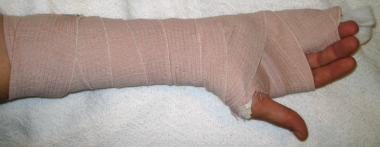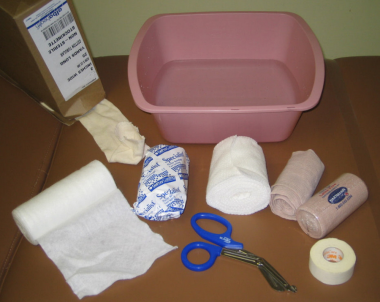

Splints are generally applied to decrease movement to provide support and comfort through stabilization of an injury. The primary purpose of a splint is as a temporary bridge for nonemergency injuries to bones until definitive casting can be performed by a consultant, such as an orthopedic surgeon. Splints can also serve as initial immobilization in the preoperative period or as immobilization for primary healing.[1, 2]
All patients with injuries that are splinted should be referred for evaluation by a consultant in a timely fashion, usually within 2-3 days.
NextAn ulnar gutter splint (see the image below) can be used for various injuries to the upper extremities, including the following:
 Ulnar gutter splint. Image courtesy of Kenneth R Chuang, MD.
Ulnar gutter splint. Image courtesy of Kenneth R Chuang, MD.
Although no true contraindications to the placement of a splint are recognized, certain injuries require immediate evaluation or intervention by a consultant (eg, orthopedic surgeon, hand surgeon, plastic surgeon) and therefore may not necessitate splinting. Such injuries include the following:
Ulnar gutter splinting itself is usually tolerated without the use of anesthesia. However, if significant manipulation or reduction of the injury is required during the splinting process, anesthetic techniques may be used. Acceptable techniques include the following:
With the administration of any analgesic agent or initiation of a formal sedation protocol, care must be taken to avoid oversedation. Perform a complete neurovascular examination before and after the splint has been applied.
Equipment employed in ulnar gutter splinting includes the following (see the image below):
 Equipment for ulnar gutter splint. Image courtesy of Kenneth R Chuang, MD.
Equipment for ulnar gutter splint. Image courtesy of Kenneth R Chuang, MD.
Place the patient in a comfortable position (eg, seated or reclined). Cover the patient with a sheet to avoid splatter from the wet plaster. (See the video below.)
Ulnar gutter splinting: appropriate coverage of patient. Video courtesy of Kenneth R Chuang, MD.Completely expose the injured limb. Remove all jewelry. In particular, rings can cause constriction and ischemia of the fingers with delayed swelling of the soft tissues. If a ring cannot be removed, try using soap as a lubricant, or consider a ring cutter. (See the video below.)
Ulnar gutter splinting: removal of jewelry and rings to avoid ischemia from swelling. Video courtesy of Kenneth R Chuang, MD.Explain the procedure to the patient, including risks and benefits. Obtain informed consent.
With the patient appropriately positioned (see Positioning), apply the stockinette. Cut longitudinally at the distal end of the stockinette to allow coverage of the fourth and fifth digits. Then, cut an adequate hole for the thumb, being careful to avoid constriction of the thumb. (See the video below.)
Ulnar gutter splinting: application of stockinette. Video courtesy of Kenneth R Chuang, MD.When measuring the stockinette, allow for extra length. The stockinette should extend 2-3 cm beyond the overlying padding on either end. In turn, the padding should extend 2-3 cm beyond the overlying wet plaster on either end. Together, the stockinette and padding will be pulled over the edges of the wet plaster to create smooth edges.
Next, place a piece of padding between the fourth and fifth digits; this helps prevent maceration of the skin. Wrap the padding over the stockinette. Overlap each layer by half the width. Also allow for extra length. The padding should extend 2-3 cm beyond the overlying plaster on both ends. Smooth out creases, unwrapping and rewrapping as necessary. Apply extra padding to the bony prominences of the wrist, the metacarpophalangeal (MCP) joints, and the interphalangeal (IP) joints. (See the video below.)
Ulnar gutter splinting: application of cotton padding. Video courtesy of Kenneth R Chuang, MD.Measure the plaster. For an adult of average size, the plaster for an ulnar gutter splint should be eight to 10 layers thick. Use plaster that is 3-4 in. wide. After counting out the layers, measure the plaster from the fifth distal IP (DIP) joint to the proximal third of the forearm. Allow for roughly 5 mm of extra length on either end; plaster shrinks when wet. Excess wet plaster on the ends will be folded over. (See the video below.)
Ulnar gutter splinting: measurement of dry plaster. Video courtesy of Kenneth R Chuang, MD.If prefabricated fiberglass is being used, the stockinette and padding steps can usually be skipped. In this case, follow the manufacturer recommendations.
Submerge the plaster in clean, room-temperature water. Allow all the bubbles to escape. This starts the lamination process of the plaster and allows the layers to bond together. Squeeze out the excess water. With the fingers, pull out the remaining water. Then, lay the plaster on a flat surface or dry towel and smooth out wrinkles and folds. This allows further bonding of the plaster layers. (See the video below.)
Ulnar gutter splinting: wetting of plaster. Video courtesy of Kenneth R Chuang, MD.Apply the wet plaster, over the padding, to the medial or ulnar surface of the forearm. The plaster should extend from the DIP joint to the proximal third of the forearm. Fold outward excess plaster on the ends. The underlying stockinette and padding should then be folded outward on both ends in such a way as to create smooth edges. (See the video below.)
Ulnar gutter splinting: application of wet plaster. Video courtesy of Kenneth R Chuang, MD.Apply the bandage wrap over the wet plaster. Start distally, at the DIP joints of the fourth and fifth digits, and wrap proximally. Cut an adequate hole for the thumb. Avoid wrapping too tightly. (See the video below.)
Ulnar gutter splinting: application of bandage wrap. Video courtesy of Kenneth R Chuang, MD.While the plaster is still wet, mold the splint into the desired shape. The wrist and hand should be in a neutral position. Extend the wrist to 20°, and flex the MCP joints to 70°. The patient's hand, wrist, and forearm should remain immobile until the splint is dry. Advise the patient that he or she may feel some warmth released from the plaster as it dries. However, if the heat becomes too intense, unwrap the splint and remove the plaster immediately. Thermal burns can occur. (See the video below.))
Ulnar gutter splinting: molding of splint. Video courtesy of Kenneth R Chuang, MD.Once the splint is dry, check for neurovascular function and capillary refill. Wipe away any plaster that may have dropped onto the patient's skin. (See the video below.)
Ulnar gutter splinting: assessment of neurovascular function and capillary refill. Video courtesy of Kenneth R Chuang, MD.Deliver appropriate aftercare instructions. Instruct the patient to rest, elevate, and ice the injured limb. Instruct the patient to remove the splint and return immediately or go to an emergency department if he or she experiences weakness or numbness, color change (pale or bluish), increasing pressure or pain, or spreading redness or streaking.
Keep the splint clean and dry. Do not stick any items into the splint. Patients can be tempted to use sticks, pens, or hangers to scratch an itch. Advise the patient that sticking objects into the splint can wrinkle the padding and lead to pressure sores or cause a break in the skin and lead to an unattended infection.
The splint should be rechecked in 48 hours. Also, arrange for follow-up with a consultant, usually in 2-3 days. If the patient received any sedation or opioids, advise against driving or alcohol consumption.
To assist in achieving neutral position of the hand and wrist, some clinicians advocate having the patient hold a can or a bandage wrap. Alternatively, the patient can imagine holding a wine glass. With either method, maintain the wrist at 20° extension.
For injuries or reductions that require shorter drying times, faster-setting plaster is available (eg, Specialist Extra Fast Setting Plaster). However, as plaster dries faster, the risk of thermal injury increases. For most splints, regular plaster (eg, Specialist Fast Setting Plaster) is appropriate.
Consider prescribing an antihistamine (eg, diphenhydramine) for itching. However, if the itching persists or worsens, evaluate the splint for complications.
Malrotation can be difficult to confirm with radiography. The best method of confirmation is clinical examination. With the second to fifth fingers slightly flexed, the nail beds of adjacent fingers should lie in the same plane. With 90° flexion of the MCP and proximal IP (PIP) joints and with DIP extension, the second to fifth fingers should point toward the scaphoid. A comparison should also be made with the unaffected hand. Any degree of malrotation usually warrants surgical intervention.
In the conventional anatomic position, with the palms facing anteriorly, the medial side of the fourth digit is the ulnar side. The ulnar nerve provides sensory function to the palmar and dorsal aspects of the fifth digit and the medial half of the fourth digit.
Patients can typically expect to feel some warmth as the plaster dries.[6] However, if intense heat or any pain is reported, the plaster should be removed immediately to prevent possible thermal burns.[7] As more layers of plaster are used, more heat is produced. Use clean, room-temperature water. Water that is dirty or too warm accelerates the drying time and increases the heat produced. Do not wrap towels or blankets around the splint to shorten drying time; this produces excess heat.
To prevent pressure sores, provide extra padding to bony prominences. When wrapping the cotton padding, avoid creases. When creases occur, smooth them out, or unwrap and rewrap as needed. When molding the wet plaster, use broad-based pressure. In other words, do not use the fingertips; rather, use the entire palmar surface of the hands and fingers to mold the plaster.
Contact dermatitis may develop with thumb spica splinting.
Increased pressure from swelling may give rise to ischemia and neurovascular compromise. If moderate-to-significant swelling is anticipated, cut the cotton padding lengthwise along the lateral or radial side of the forearm before applying the wet plaster on the ulnar side. This allows for expansion of the padding. If using tape to secure the outermost bandage wrap, do not tape circumferentially.
Immobilization may result in decreased range of motion. Advise the patient that, depending on the extent and nature of the initial injury, he or she can often expect long-term pain, arthritis, stiffness, and decreased range of motion, despite best care practices. The aftercare of such injuries often requires physical therapy.
Copyright © www.orthopaedics.win Bone Health All Rights Reserved